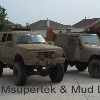Organic Brake Pads
Organic brake pads (also known as NAO, or “non-asbestos organic”) were developed as an alternative to asbestos pads, composed of various fibers mixed with binding resins to hold them together. Some common materials used in organic brake pads include glass, fiber, rubber, carbon and Kevlar. The materials and tools used to manufacture organic brake pads are still the least expensive today, which is why the majority (roughly 70%) of new cars sold in the US still come with them from the factory.
Pros:
• Soft, quiet, easy on brake rotors
• Don’t require much heat to generate good friction
• Produce less dust than metallic pads
• Low manufacturing cost
• Suitable for normal driving/commuting across many environments
• Perfect for every day vehicles and drivers
Cons:
• Only operate well within a relatively limited temperature range
• Wear out quickly compared to other types of brake pads
• High compressibility – can cause “mushy” brake pedal feel
• Will quickly lose their coefficient of friction when overheated
• Not at all suitable for performance driving
Semi-Metallic Brake Pads
As the name implies, semi-metallic pads contain anywhere from 30-65% metal by weight, typically consisting of steel, iron, copper, etc. combined with friction modifiers and fillers, as well as a graphite lubricant. Semi-metallic brake pads are arguably the most versatile style available, with the slight compromise being more noise and dust. They are also longer lasting and more durable, and their metallic composition can help draw heat away from the rotor and aid in more efficient brake cooling.
Pros:
• Dramatically increased braking performance over organic pads
• Have a much higher thermal threshold due to metallic content
• Still provide good cold bite
• Have a much wider operating range (temperature)
• Low compressibility – will provide a firmer brake pedal feel
• Much more resistant to brake fade than organic pads
• Numerous compounds available – suitable for anything from daily street driving to extreme track use
Cons:
• Tend to be noisier than organic or ceramic pads
• Produce more brake dust
• More abrasive than other types of pads – will wear brake rotors more quickly
• More expensive than organic pads (but generally cheaper than ceramic)
• Require careful and proper bedding-in for best performance
Ceramic Brake Pads
The comparative new kid on the block is the ceramic brake pad. Ceramic pads are composed of a dense ceramic material (like pottery fired in a kiln) with embedded copper fibers. In use since the 1980s, ceramic pads were developed as an alternative replacement for organic and semi-metallic brake pads because at the time these types produced too much noise and dust. Ceramic pads are also generally easier on rotors than semi-metallic pads.
Pros:
• Quieter than semi-metallic pads – emit noises that are above the range of human hearing
• Produce finer, lighter-colored brake dust which does not stick to wheels
• Longer lifespan than organic or semi-metallic
• Stable under a wide range of temperatures for consistent performance
Cons:
• Typically the most-expensive type of brake pad
• Do not produce as much cold bite as semi-metallic pads – may not be ideal in extremely cold climates
• Do not absorb heat as well as semi-metallic pads which can increase brake system temperatures
• Good all-around braking characteristics but were never designed as heavy duty/racing brake pads










